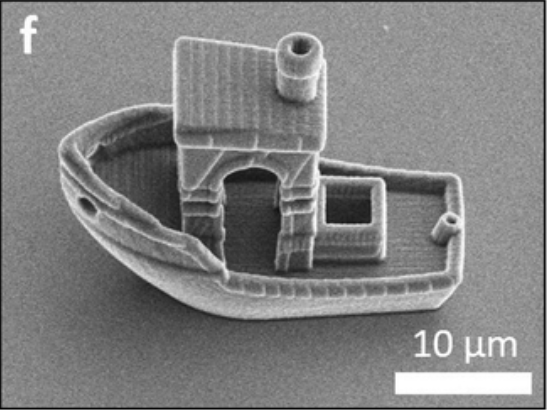Words By Amy-Rose Collins
Researchers at Leiden University in The Netherlands, helmed by Drs Rachel Doherty and Daniela Kraft, have created the worlds smallest 3D printed boat. At just 30 micrometers long, it’s the perfect size to drift along a human hair, and is 260,000x smaller than the current Guinness World Record holder for largest 3D printed boat. You can see the adorable tug boat set sail on the university’s YouTube channel. The focus of their research is on how the smallest creations – or, ‘microswimmers’ – are able to move, and how this is related to their shapes.

The purpose of this delightful endeavour was to show that 3D printing can be used to produce detailed, tiny objects. Prior to the use of this more sophisticated technology, scientists had been limited in the shapes of microswimmers they were able to create; mostly spheres and spirals. The team used a commercially available microprinter to print a variety of shapes, including a spiral and a spaceship from the Star Trek franchise. The boat in particular has special significance for proving the utility of the technology, however.
Nicknamed “3DBenchy”, short for ‘benchmark’, the boat is a popular tool for owners of 3D printers to test and fine tune their set-ups. The official website proclaims Benchy-printing to be a “jolly 3D printing torture-test”. The boat’s detail and tricky angles provide a challenge to printers. As we can see, Leiden’s boat is perfectly sea-worthy! But…how is it sailing exactly?
Natural microswimmers, such as bacteria and sperm, wave long whip-like appendages to propel themselves through their environment. Scientists employ a variety of techniques to make their synthetic versions move, including using electromagnetism to give them the necessary push. Benchy’s fuel specifically comes from a chemical effect called diffusiophoresis, where movement is caused due to different concentrations of fluids surrounding an object.
Doherty et al. gave Benchy a pretty platinum patch on its stern, then dropped it into a pool of hydrogen peroxide (the same stuff found in bleach blonde hair dye). Platinum is a known catalyst for the decomposition of hydrogen peroxide – it’s good at helping hydrogen peroxide break down into other things. As the surrounding hydrogen peroxide comes into contact with the platinum patch on Benchy’s stern, it is broken down into water and oxygen.
Now there is a difference in concentrations of the fluids surrounding the little boat, with hydrogen peroxide ahead and a mix of water and oxygen behind, exerting a bit of pressure. This pressure on the stern is what propels Benchy forward, into more hydrogen peroxide, where the process begins again. To the team, this revealed another advantage of using a 3D printer to create their microswimmers. Unlike previous methods, printing allows much greater control over where the patch is placed on the swimmer, and therefore over which direction it travels.
This test passed, the team hopes the technology can create more interesting shapes for further study of intertwined shape and movement in the realm of the small. Fun though it may be to watch a miniature tugboat glide across the microscope lens, the long term goals for this research reach beyond joy and whimsy. Greater understanding of how microswimmers behave, and how we can create and control our own, may lead to applications in healthcare, such as therapeutic diagnostics and precise delivery of drugs. Not bad for the maiden voyage of the worlds tiniest boat.

